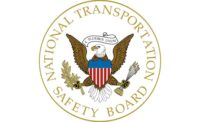The National Transportation Safety Board (NTSB) has issued a preliminary report on an incident that added a little extra madness to March Madness, when a plane carrying the University of Michigan men's basketball team to the Big Ten tournament in Washington, D.C. slid off the runway March 8.
All 109 passengers and seven crew members were evacuated safely via escape slides after the rejected takeoff and runway excursion at Willow Run Airport in Ypsilanti, Michigan. One passenger sustained a minor injury during the evacuation.
Shortly before the incident, winds were gusting up to 53 miles per hour at the nearby Ann Arbor Municipal Airport.
The NTSB said the Ameristar Air Cargo Inc. Boeing MD-83 came to rest about 1,000 feet past the end of runway 23L.
The NTSB’s investigative update does not provide probable cause for the accident and does not contain analysis of information collected thus far in what is an ongoing investigation.
Experienced pilots
It does contain the following facts:
- Parties to the investigation include the Federal Aviation Administration, The Boeing Company and Ameristar Air Cargo, Inc.
- Both pilots held airline transport pilot certificates with DC-9-series type ratings (this rating includes the
- MD-83).
- The pilot-in-command, who was the Ameristar chief pilot, was in the right seat and was providing differences training to the captain, who was in the left seat and was the pilot flying the aircraft.
- The Ameristar chief pilot had 9,660 total flight hours, with 2,462 hours in DC‑9‑series airplanes. The captain (flying pilot) had 15,518 total flight hours, with 8,495 hours in DC-9-series airplanes.
A part was jammed and damaged
Post-accident examination revealed movement of the control column in the cockpit appeared normal; the control columns were free to move, and the elevator control tabs moved as commanded. However, when investigators tried to move the elevator surfaces by hand, the left elevator moved normally, but the right elevator was jammed in a trailing‑edge-down position (airplane nose down). Upon further inspection, the right elevator geared tab inboard pushrod linkage was found damaged which restricted movement of the right elevator surface but allowed movement of the control tab. After the damaged components were removed, the elevator could be moved by hand.
(The March 10, 2017 NTSB image above depicts the displaced inboard elevator geared tab linkage, highlighted by the arrow, from Ameristar Air Cargo Inc., flight 9363. The red piece of metal is included in the image for reference only an is not part of the elevator system).
Examination of the flight data recorder data indicates that during the taxi and take-off roll, the left elevator moved normally, but the right elevator did not move. During takeoff roll, the left elevator began a large airplane nose-up movement (consistent with rotation) at an airspeed of about 152 knots and continued for five seconds to about 166 knots. There was no change in the airplane pitch attitude during this time. The airplane data then are consistent with the takeoff being rejected. The maximum recorded airspeed was about 173 knots.
Plane flew fine two days earlier
Review of previous flight data showed normal movement of both the left and right elevator surfaces. The airplane flew to Ypsilanti two days before the accident.
The flight and cabin crewmembers indicated in post-accident statements that all slides except for the forward right door deployed correctly. The slide was removed from the airplane and will be examined by investigators at a future date.
NTSB investigations generally take 12 to 18 months to complete. The preliminary report for the investigation is available online at https://go.usa.gov/xXkXx.



